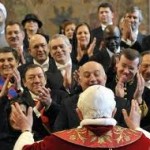Holy See, diplomatic risks on its future?
 Does the Vatican still have any International weight?
Does the Vatican still have any International weight?
If you look at its whole diplomatic network, spread all over the world, the answer would be yes. The last time Pope Benedict met his ambassadors, their number was of 178 diplomats and two special relationships. As for the number of diplomatic relations, the Holy See follows only the United States.
But the times when the moral authority of the Catholic Church still used to hold a substantial weight seem now light-years away, and the Pope’s recent speech to his Ambassadors is the proof. In that speech, Pope Benedict only made some generic appeals about the Egyptian situation. It was just a few days after the terroristic attack in a Coptic Church in Alexandria – the riots had not started yet- when the Pope underlined that «this series of attacks is yet another sign of the urgent need for the governments of the region to adopt, in spite of difficulties and dangers, effective measures for the protection of religious minorities».
These words had somehow an impact on the Egyptian hierarchies. The Egyptian government decided to call back Aly Hamada Mekhemar -the Egyptian ambassador to the Holy See- for consultation, a choice with an international political significance. Ambassadors are often called to report about the country they’re living in, and this is definitely the case. Neverthless, some Vatican insiders have hazarded a guess which opens new scenarios. And that, after all, does not sound that weird. In fact, the crisis between the Holy See and Egypt might just be the first of many in which diplomatic bodies will justify their future choice to close their embassies to the Holy See. What is the reason why states should keep two embassies in Rome, while one -dealing with both Italy and the Vatican at the same time- would be enough?
Good question. Even more because, in the public debate, the Holy See seems to be totally absorbed by Italians matters. The Holy See Permanent Observers do a great job, with their wide-range speeches and their sound international perspectives. Take, for example, the message for the World Day of Peace, «Religious Freedom, the Path to Peace», which showed a clear shift of paradigm by the Holy See. By focussing on the freedom of the individual subject of national and international law, no space is left for collectivism (expressed by the various “phobias” of international organizations: Islamophobia, Christianophobia, omophobia) or individualism. «We want – a Holy See official explains – that communities are protected, not to protect the ideas of the communities».
Nunciatures too (the Holy See embassies) do a great job on the field. Because of the nuncios’ great knowledge on the field and their skills, the *Osservatore Romano* is widely considered – even by a large number of diplomats – the best newspaper in Italian language for foreign politics issues.
In the end, there is the hard work coming from below, from those missionaries of the Congregation for the Evangelization of Peoples and from those in the ecclesial movements who have represented the real novelty in the Church of this century.
However, not much is known about the international activity of the Holy See. The Secretary of State seems busier getting involved in the political issues of the ‘Belpaese’ than in promoting wider projects. During the so-called ‘Ruby gate’ (the series of sexual scandals involving the Italian Prime Minister Silvio Berlusconi), the Italian media have spent weeks attacking the Holy See because of its silence. However, it was obvious: the Holy See is a diplomatic subject. Asking the Holy See to give its opinion on the matter wouldn’t be different from asking Obama a statement about Berlusconi’s morality. However, the Secretary of State Cardinal Bertone could not resist the media pressure, and decided to speak. He talked about a general “morality” for public people. But his words were sufficient for the media to flag Bertone’s attack on Berlusconi.
This is just an episode. But it is not an isolated one. In the meantime, Christianity is on the move. Throughout the last 100 years, the percentage of Christians in the world population was stable at 33 per cent. However, it’s the Christian ethnic background that has globally changed. And it changed significantly, modifying in fact the global profile of the Christian individual. In 1900, 81 percent of Christians were white and European. Nowadays, white European Christians are less than 45 percent of the total, and they’re on the decrease. At the same time, the number of Asian, African and Latino-American Christians has surged. According to forecast, in 2025 and 2050 the Christian prototype will be much less European and much more coming from the South of the World. With one only exception, though, as the United States will be on the top of “Christian” chart. In 2050, eventually, some European countries might have disappeared from the chart of Christian Countries. Latino American, Asian and African countries, instead, will be the “new entries” of the chart. Moreover, if we compare the Christian and the Muslim presence, we can notice another significant data, as some countries -such as India and Nigeria- figure in both charts.
This data is food for thought. It shows the need for a much more internationally-oriented presence of the Holy See in the in the debate, to meet the faithful of a global and globalised world, less and less Italian and -let alone- European, and to bring the religious phenomenon in the midst of the debate, through presence and dialogue. Less Italy, more world; this is the next challenge of Roman Curia.





Bell’inizio!
Complimenti da tutta la famiglia!!!!! Siamo orgogliosi!!!
Buon avvio !!!
gagliarducci the great.
Bravo!!!
(un applauso anche alla povera figura del traduttore, che non viene nemmeno citato!!! ghghgh)
Sono fiera di te!